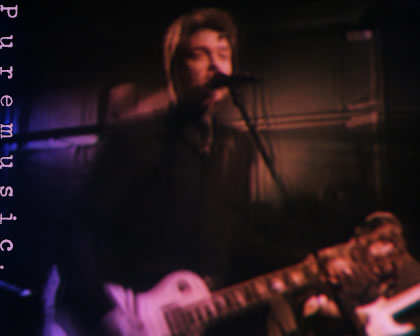
A Conversation with Joe Henry (continued)
JH: And that's how I found myself in what became the alt-country world.
PM: So that Jayhawks-intended record--what was that called?
JH: It's a record called Short Man's Room. I went to Minneapolis months later, and over the course of a weekend, we did some live to 8-track tape demos, which just became that record. Because I liked the recordings well enough, I thought, "I don't really want to go get a deal and then go redo this. I think it just is what it is."
PM: Yeah, because you'd never beat the demos anyway.
JH: Yeah. It just had a good spirit to it, and it was a really fun project.
PM: So Short Man's Room is an eight-track album.
JH: Yeah.
PM: Bitchin.
JH: I think I bought them a case of beer or something--
PM: [laughs]
JH: I didn't pay them any money. We just spent these long nights--there's an engineer and producer who used to work for Rykodisc in Minneapolis. He was an engineer at the same time, and he had a deal with them that evenings and weekends he could use their office space as a recording studio. So when we made Short Man's Room we showed up at 7 o'clock on a Friday night and had to be out by 7 o'clock Monday morning.
PM: Unbelievable.
JH: So that's basically what we did, put the drums in the conference room.
PM: [laughs]
JH: Gary Louris and Mark Olson and I were all sitting at three secretaries' desks in a row. All sitting in front of their pictures of their families--
PM: Unreal...
JH: --and their paper clips, and kind of sitting in a row. And that's what we did. That's a long way of telling you how I found myself there.
PM: Right.
JH: And I signed to Mammoth Records based on them hearing it as a finished record. And that was a relationship that continued and mutated. They were owned by Atlantic at one point, then owned by Disney. But I operated under their banner until after Scar.
PM: So Short Man's Room was the first Mammoth record.
JH: Right. And at that point, I just continued to try to figure out how to expand my musical vocabulary and keep working. And I made one more record called Kindness of the World, where I used the bulk of the Jayhawks and some other players as well. But by the time I'd finished that record, even before it came out, I was exhausted and frustrated with the process, and felt like it didn't begin to articulate what I wanted to do.
I felt I'd really limited myself by--I had so little in the way of resources to make a record that--I only knew how to go into a room with a bunch of people live and go after takes, because that was the fastest way--the only way I'd ever known to work. But I finished that second record with the Hawks and came away kind of disgusted with myself because I had a much greater ambition for that record than I knew how to realize. I came home saying, "If I don't find another way to work, I'm done, because I won't make another record that way."
PM: Wow.
JH: And then I'd worked on a few records as a production associate--assistant, whatever you want to call it--with my friend T-Bone Burnett. And during the first record we made together in that configuration, we were working on a record with Bruce Cockburn. I had just moved to Los Angeles from New York at that point, and we worked on a record with Bruce. And through T-Bone, I very quickly made the acquaintance of people like Jim Keltner and Booker T.
PM: Wow.
JH: And Edgar Meyer, and some really interesting people I'm still really friendly with. I mean, Jim Keltner, who's remained a good friend. And it just opened my mind up to throwing myself into a bigger pond.
And I met the engineer Patrick McCarthy, who was a young man from Ireland who came to the States with U2, and is now producing his fourth R.E.M. record, I guess. He's been doing that for--since they jumped from Scott Litt. And Patrick and I were playing a lot of racquetball together.
PM: [laughs]
JH: And he has a completely different history than I did. He came up in Ireland recording with the London Philharmonic and U2, and then came to the States and worked with Robbie Robertson and Daniel Lanois. He just came from a whole different world--he'd never worked on records that really had a budget, or where a budget really meant anything.
PM: [laughs]
JH: He worked for people where there was always more time and more money if you decided you wanted to spend it.
PM: Wow.
JH: And he became a good pal. I talked a lot with him about my frustrations with the way I was working. And I decided to work with him on my next record and just learn a new way to work. I said, "I've got to start over and learn to operate in a different way." So he and I made Trampoline together. And a lot of that was him setting me up with a small recording unit in my garage so that I could work alone.
PM: What kind of a unit was that?
JH: Oh, just a D-88.
PM: Yeah.
JH: He loaned me a really good mic, like a Neumann U-67. So I had one signal chain, one mic pre and one compressor and then the tape. And I just moved this mic in front of everything.
PM: [laughs] continue